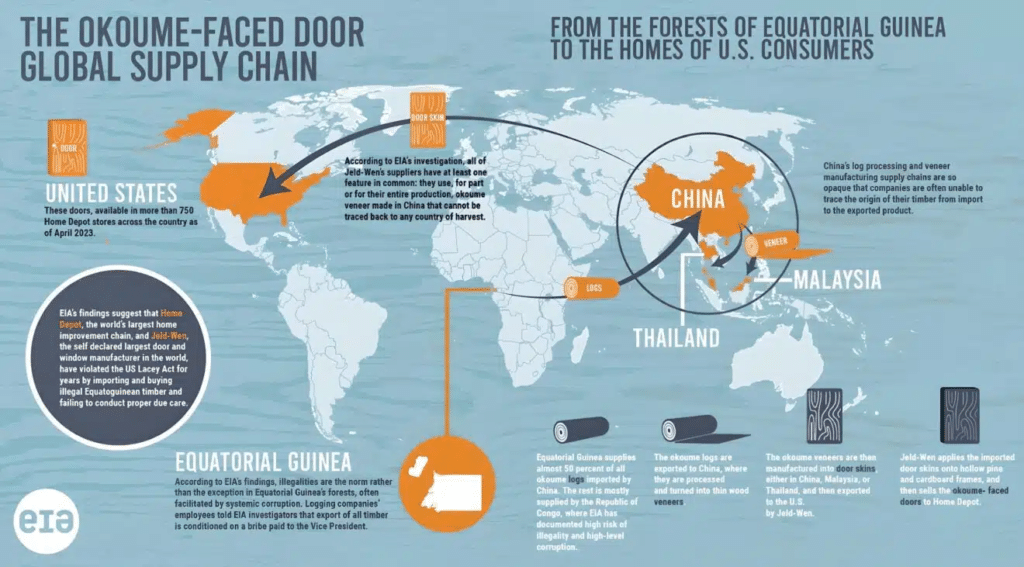The world continues to lose more than ten football pitches of forests every minute, with agricultural cultivation—where forests are clear-felled and converted into agrarian crops—the primary driver of tropical deforestation.
That is according to the University of Maryland and the World Resources Institute (WRI), the publisher of new data confirming that 2023 losses totalled an area the size of Bhutan (or 37,000 square kilometres), with 76 million hectares of tropical forest lost in the last 21 years alone.
According to Mikaela Weisse, the WRI’s Global Forest Watch Director, “The world took two steps forward and two steps back.” While Brazil (36%) and Columbia (49%) took major strides in reducing deforestation, forest clearing surged in Bolivia, Laos, Nicaragua, and the Congo. At the same time, Canada lost 8 million hectares of non-tropical forests to wildfire.
“Steep declines in the Brazilian Amazon and Colombia show that progress is possible, but increasing forest loss in other areas has largely counteracted that progress,” Ms Weisse said, adding, “We must learn from the countries that are successfully slowing deforestation.”

And yet, despite the significant progress in the Amazon and a pledge by global leaders at Cop26 and reinforced at Cop28 to halt and reverse forest degradation, global governments remain “dangerously off track when it comes to meeting climate and biodiversity commitments.”
According to data, the Democratic Republic of the Congo—now serving Chinese veneer and plywood manufacturing hubs—lost more than 500,000 hectares of rainforests last year. Although this only represented a 3% uptick, the loss rate over many years adds up.
“Forests are the backbone of livelihoods for Indigenous people and local communities across Africa, especially in the Congo Basin,” according to Teodyl Nkuintchua, Congo Basin Strategy and Engagement Lead at WRI, who added that the government must intervene to protect the last remaining tropical forest carbon sink.

That includes Brazil, where primary forest cover has reached its lowest level since 2016—down from 43% in 2022 to just 30% in 2023. Mariana Oliveira, the Manager of Forests, Land Use, and Agriculture Program at WRI Brasil, said, “We’re incredibly proud to see such stark progress being made across the country, especially in the Brazilian Amazon.” However, Ms Oliveira said, “We still have a long way to go to improve and sustain the efforts…to build on this momentum rather than using it as an excuse to slow down.”
Meanwhile, in Columbia, where primary forest loss halved from 2022 to 2023, “the story of deforestation in Colombia is complex and deeply intertwined with the country’s politics, which makes the historic decrease powerful,” according to Alejandra Laina, Natural Resources Manager, WRI Colombia, with centre-left Brazilian and Columbian presidents, Luiz Inacio Lula da Silva and Gustavo Petro, pushing for a climate pact as part of the historic Amazon summit last year.
In Asia, Indonesia saw a 27% increase in loss, largely thanks to an elevated fire season—although, like Malaysia, forest loss is far lower historically compared to the peak of the mid-2010s. Since 2019, both countries have operated under a moratorium on logging in new palm oil plantations, with 83% of all palm oil now subject to no deforestation, peatland, or exploitation commitments.
“This report appropriately challenges us to balance despair and hope at the same time. The alarmingly high global deforestation rates remind us how badly off track we are in solving the climate and nature crises,” Dr Andrew Steer, President and CEO of the Bezos Earth Fund, said.
However, “countries such as Colombia, Brazil, and Indonesia are demonstrating amazing possibilities when modern data and science combine with smart policy design and inspiring leadership.”
How is deforestation measured?
Tree cover loss is analysed via satellite images, although there is sometimes uncertainty about the precise year trees are lost.
Measuring deforestation – which typically refers to human-caused, permanent removal of natural forest cover – is more complicated because not all tree-cover loss counts as deforestation.
Scientists consider all of these factors to estimate deforestation. The latest figures suggest a rise in (human-caused) global deforestation of 3.5%, similar to 2022 levels— the opposite direction of the Glasgow commitments, which pledged to eliminate deforestation by 2030.

“Satellite data helps us monitor the extent of wildfires over the years, including those leading to tree cover loss,” according to Alexandra (Sasha) Tyukavina, Associate Research Professor at the Department of Geographical Sciences, University of Maryland. “This is especially important in understanding how extreme fire years — like Canada’s 2023 record-breaking wildfire season — impact the world’s forests over time.”
According to Professor Matthew Hansen, a remote sensing specialist at the University of Maryland’s geography department, “I believe the only way to maintain standing forests is to establish a compensation fund for conserving standing rainforests.”
He said, “Germany has floated the ‘Fair Deal‘, which is meant to pay rainforest countries this way,” while “Norway has engaged with Gabon, using carbon sequestration as the measure.” He added that this approach, coupled with “robust governance and civil society engagement, might work.”
- To learn about the 2022 report, visit Wood Central’s special feature.







